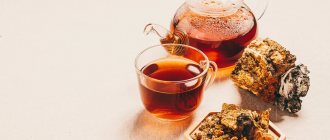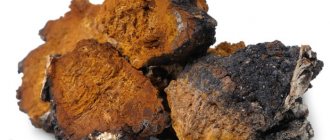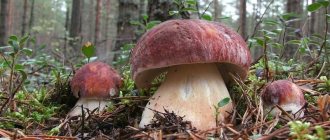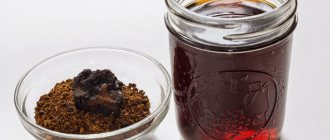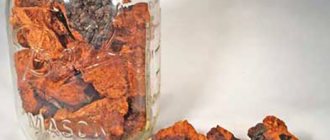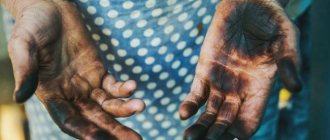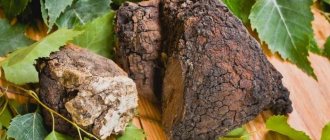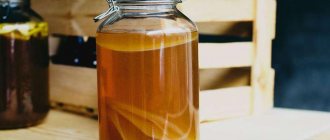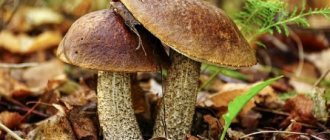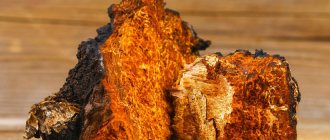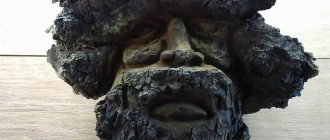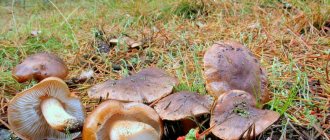AnyutaN — Jan 9th, 2022 Category: Dried mushrooms
Tags: Dried chaga
Chaga (birch mushroom) are small growths on deciduous trees. You can find mushrooms on trees such as alder, maple or rowan, but only birch chaga has unique medicinal properties. The benefits of these growths are undeniable. Since ancient times, they have been used by traditional healers to treat various diseases, including malignant neoplasms. Also, tinctures, decoctions, or simply brewed into tea are prepared from chaga. We’ll talk about how to properly collect and dry chaga for the winter in this article.
Ingredients: chaga Time to add: All year
How and when to collect chaga
It is believed that birch chaga can be collected all year round, but in summer this is problematic due to the leafy mass, which makes it difficult to find chaga, and in winter - due to deep snowdrifts. Traditional healers claim that chaga concentrates the maximum amount of useful substances in the spring, before the greenery blooms, or in the autumn, after the leaves have fallen.
Watch the video from the channel “Health - Life!” — Chaga beneficial properties and uses
In order to cut chaga from a tree, you need to arm yourself with a sharp, thick knife or a small hatchet. Useful growths cling quite tightly to the trunk, which makes the procedure for collecting chaga quite labor-intensive.
It is necessary to distinguish the birch mushroom from the pest growth of the tinder fungus. Chaga always has an irregular shape and black color. The tinder fungus has the shape of a hoof and differs from chaga in lighter shades. At the same time, it can be separated from the birch trunk without much effort by hand.
You should not collect chaga from dead trees or growths located close to the ground. It is believed that the most useful product is located as close to the top of the tree as possible.
It is also better to collect chaga in birch groves, and not on lonely growing trees. It is believed that the mushrooms located on birch trees in a “company” contain much more useful substances.
Processing of collected chaga
After the chaga growths are separated from the trunk, they should be processed in a certain way. The fact is that not all parts of the birch mushroom are equally suitable as a medicine. And if in one part of the mushroom there are a lot of useful substances, then in others there are practically none at all. How can this be determined? It turns out that the light and loose part of the mushroom adjacent to the trunk is of least benefit. This is what you should get rid of, as well as all kinds of chips and pieces of birch bark right on the spot, in the forest.
You only need to leave the hard parts of the mushroom - the outer and middle ones. It is best to chop the collected raw materials into small pieces right next to the tree.
Next, fresh chaga should be dried, but there are also certain subtleties here. The fact is that fresh chaga mushroom is easily susceptible to mold, so it should not be dried in an area that is too damp, cold, or poorly ventilated. But under no circumstances should you put chaga in a hot oven for quick drying, otherwise most of the biologically active substances will be lost. Therefore, you need to find a middle ground - choose a dry, warm and well-ventilated place. In this case, fresh chaga must be cut into pieces no larger than 3-6 cm and dried until the pieces become hard and crumbly. Well-dried birch mushroom should be placed in glass jars with tight-fitting lids; it can also be packed in airtight paper or linen bags. Properly collected, prepared and stored mushroom retains all its medicinal properties for 2 years.
Preparing chaga for drying
The collected raw materials should be prepared as follows:
- pieces of chaga are beaten with a sharp knife, getting rid of the light, loose part that was in contact with the wood;
- using an ax, remove the hard black bark covering the top of the chaga;
- the brown inner part is cut into pieces no larger than 3 - 5 centimeters in diameter.
Watch the video from the “Tactical+” channel about the proper collection, cutting and brewing of birch chaga
What is the difference between chaga and tinder fungus?
Tree fungi also include tinder fungi, which also like to grow on birch trees. To avoid mistakes, pay attention to the following nuances:
- Chaga will always be very hard, and tinder fungus will be softer. You can easily cut even the largest mushroom with a knife.
- The “body” of chaga is almost uniform in shape, very lumpy, without a clearly defined stalk. In the tinder fungus, the leg is clearly visible - it looks like a hoof.
- Chaga is always dark on top and red inside, while tinder fungus is most often light gray in color.
- Medicinal birch mushroom grows only on living trees. Whereas poisonous tinder fungi prefer dry stumps and fallen trunks.
How to dry birch mushroom
The main and most correct way to dry chaga is natural, without the use of special heating devices.
The prepared pieces are laid out in a small layer on paper and placed in a dry, well-ventilated room. Also, it is important to protect raw materials from direct sunlight.
In summer, chaga can be dried on verandas or under a canopy, and in winter it can be placed on window sills, protected from the sun, not far from heating radiators. Natural drying time is 2 – 3 weeks.
You can also dry chaga in the oven. Drying time is reduced to 8–10 hours, but the risk of losing some of the nutrients remains. The oven is heated to a maximum temperature of 50 degrees, and the door is kept ajar.
Modern electric dryers can also cope with the task of quickly drying birch chaga. To do this, the unit is heated to a temperature of 40 degrees and the raw materials are dried for 7 - 8 hours, periodically rearranging the trays in places for more uniform drying.
Application of birch chaga
Chaga is not used in its natural form. This mushroom is not used for food. More often, medicinal compositions are prepared on its basis. Pharmacies sell medications for oral administration. There are creams and ointments for external application.
Popular products based on birch chaga:
- oil. Used to treat joints and varicose veins. The product accelerates the healing of wounds and trophic ulcers. Mix unrefined vegetable oils with aqueous decoctions. Either pour in the pieces and leave to infuse;
- ointments for cancer, skin problems. The water infusion is combined with pork fat;
- decoctions, infusions. Use 150 g of dried birch growth per liter of water. Used internally, added to external products;
- alcohol tinctures. The pieces are poured with moonshine, vodka, and left for 3 weeks. Used to treat oncology, strengthen the immune system, and normalize metabolism. Add to ointments and creams.
People use tea to strengthen the immune system and lose weight. Brew 5 g of dried product with 200 ml of boiling water and infuse. You can drink up to three glasses per day.
Any self-medication can harm your health. Before use, we recommend consulting with your doctor.
Read more about preparing chaga
On an industrial scale, the preparation, drying and processing of the cup is carried out by pharmaceutical enterprises. The raw materials are used to produce dietary supplements, skin care cosmetics and therapeutic and prophylactic drugs. On the shelves you can find products in which tree mushroom extract or decoction is the main active component:
- medicated shampoos, hand and foot creams, lotions;
- teas (restorative and in combination with other medicinal plants);
- bath salts and concentrates for adding to water;
- ointments for treating joints, healing wounds and scars.
Large-scale purchase and processing of raw materials is carried out all over the world, but most actively in Asia - in Japan and China.
A significant portion of the proceeds purchased on the territory of the Russian Federation goes to the Celestial Empire. On the territory of the Russian Federation, since the late 80s, the volume of delivery has fallen. Chaga is used among the population by private companies or individual healers. Prices for raw materials (for 2022) are 130–150 rubles.
Important! The cost of harvest depends on the quality of raw materials, freshness and harvesting region. Cleanliness and degree of shrinkage are assessed. A raw, unprocessed mushroom costs no more than 50 rubles kg (price for 2020).
Biologically, the entire mass of the fungus is divided into fruit and spore parts. Both forms can be used, although the fruit form – shapeless black protrusions – is considered more valuable. Proper harvesting of birch chaga involves sorting the raw materials before delivery.
Biologically active parts, as raw materials with high value characteristics, are processed to prepare dietary supplements and tinctures for oral administration. Less valuable parts (spore mass) are collected to prepare preparations for external use.
To prepare collections and decoctions, properly dried and crushed chaga pulp is used. The top black layer is not recycled. Therefore, large units with a diameter of more than 7 cm (after cleaning and chopping) are most valued. The list of areas with which harvesters cooperate does not include the Sverdlovsk and Chelyabinsk regions, which are characterized by poor environmental conditions.
Due to the large number of defects, entrepreneurs try not to cooperate with private traders who spontaneously decided to make money by picking mushrooms.
Citizens planning to organize a business in chaga are advised to first join existing cooperatives and figure out how to properly prepare it in practice.
General information about the mushroom
It is a type of Tinder fungus; this mushroom is often called the beveled Tinder fungus or birch mushroom. Outwardly it resembles an oval-shaped brown growth. Initially, it may seem that the mushroom is soft, but this is only around the edges. Mown polypore cannot be removed without using a knife or axe. Weight is approximately 4 kilograms.
The mown tinder fungus is considered a parasitic fungus, since during its development it destroys the tree. The approximate life cycle is 10 years. It dies at the same time as the tree on which it grows.
Despite the fact that the mushroom is not considered beneficial for trees, it has a number of healing properties and characteristics for human health (the age of the fruiting body does not play a role):
- improves immunity and eliminates infectious diseases;
- has a calming effect against stress and depression;
- quickly eliminates skin diseases such as psoriasis, acne and post-acne, acne, diathesis;
- good for insomnia;
- used for gastrointestinal diseases (gastritis, ulcers);
- acts as a biostimulant;
- used for chemotherapy.
Chaga contains:
- potassium – maintains blood pressure, prevents stroke;
- manganese – normalizes gastrointestinal processes, stabilizes the immune system;
- fiber – prevents intestinal and gastric diseases, normalizes digestion;
- lignin is a substance that can remove waste and toxins from the body;
- oxalic acid – improves metabolism;
- formic acid – has an anti-inflammatory effect, relieves swelling and reduces pain;
- vanillic acid – eliminates harmful bacteria;
- zinc – improves the functioning of the cardiovascular system, restores hormonal imbalances;
- copper – strengthens bones and increases hemoglobin;
- iron – stimulates the thyroid gland, strengthens the immune system.
- decoction;
- ointment;
- oil;
- alcohol from chaga;
- tinctures and solutions.
Chaga: medicinal properties
1. Chaga is a natural biostimulant.
2. Chaga medicines are used to prevent malignant tumors. In the initial stage of cancer, medicines from the fungus reduce the growth of diseased cells.
3. Chaga relieves the condition of a patient with tuberculosis and improves the quality of sleep.
4. The medicinal mushroom has long been used as an antimicrobial and antiseptic agent.
5. Effective chaga preparations are used to treat kidney diseases or disorders of the liver, pancreas and gall bladder.
6. Chaga reduces fever and makes breathing easier during colds such as bronchitis.
7. Vitamins strengthen the immune system.
8. Stearins reduce blood cholesterol.
9. Tannins help the protein coagulate, thereby helping to form a film that protects the mucous surface.
10. Thanks to the phytoncides, flavonoids, and alkaloids included in the composition, chaga preparations have choleretic and diuretic properties.
11. Melanin and trace elements contribute to the patient’s recovery.
12. Chaga preparations are used to treat psoriasis, frostbite, eczema, and oral diseases.
